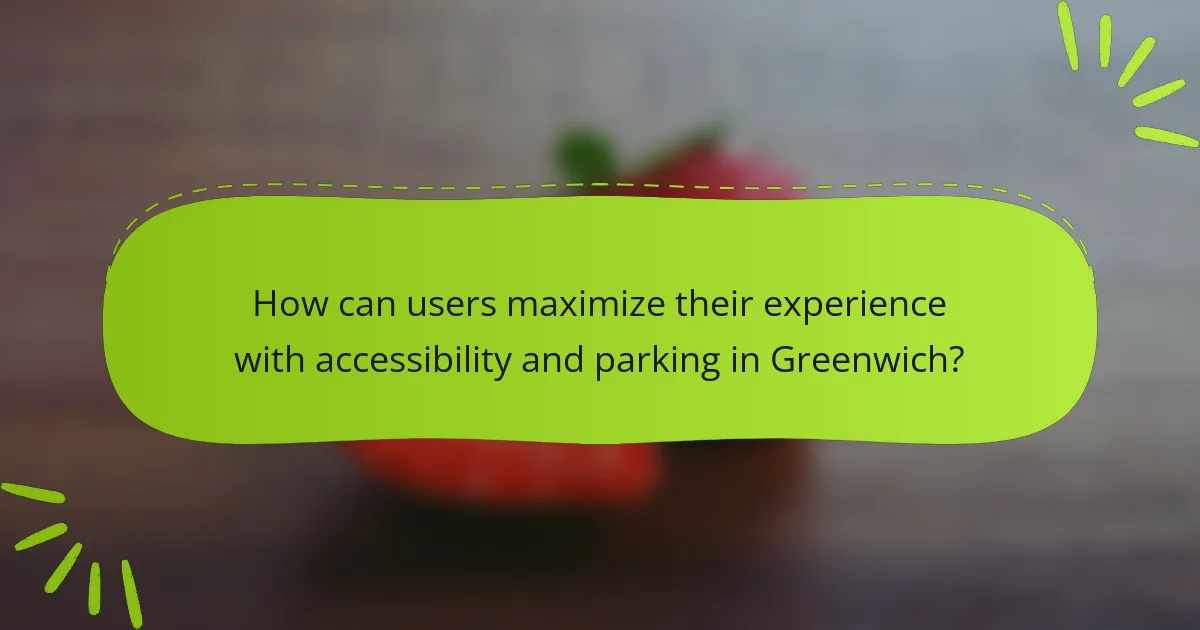Greenwich locations provide excellent accessibility and parking solutions, featuring well-connected public transport options such as trains and buses. The infrastructure supports both pedestrian and vehicle traffic, ensuring convenience for residents and visitors. Accessible parking spaces are strategically located near building entrances, enhancing mobility for individuals with disabilities, the elderly, and families. Additionally, local parking regulations and apps facilitate efficient navigation and real-time availability of parking spaces. Improved accessibility not only promotes social inclusion but also contributes to local economic growth and public safety in the area.

What are the key features of Greenwich locations regarding accessibility and parking?
Greenwich locations offer excellent accessibility and parking features. Many areas have well-connected public transport options, including trains and buses. This facilitates easy commuting for residents and visitors. Additionally, parking facilities are available throughout the area. These include on-street parking and designated parking lots. Some locations also provide accessible parking spaces for individuals with disabilities. The overall infrastructure supports both pedestrian and vehicle traffic efficiently. This combination enhances the convenience of traveling within Greenwich.
How do Greenwich locations ensure accessibility for all users?
Greenwich locations ensure accessibility for all users through various design features and services. They implement compliant ramps and elevators for wheelchair access. Wide pathways accommodate pedestrians and those with mobility aids. Signage is clear and includes Braille for visually impaired individuals. Parking spaces are designated for disabled users, making access easier. Public transport options are designed to be accessible, with low-floor buses and accessible train stations. Regular assessments are conducted to improve facilities based on user feedback. These measures align with accessibility standards, promoting inclusivity for all visitors.
What specific accessibility features are available in Greenwich locations?
Greenwich locations offer several specific accessibility features. These include wheelchair ramps at building entrances. Many public spaces have tactile paving for the visually impaired. Accessible restrooms are available in various facilities. Designated parking spaces for individuals with disabilities are present. Public transportation options include low-floor buses and accessible train stations. Elevators are installed in multi-story buildings to aid mobility. Additionally, some venues provide audio-visual aids for those with hearing impairments. These features collectively enhance accessibility for all visitors in Greenwich.
How do these features compare to other urban areas?
Greenwich’s accessibility and parking solutions are generally more efficient than those in many other urban areas. The area boasts a higher number of available parking spaces per capita, which reduces congestion. Additionally, public transport options in Greenwich are more integrated, offering seamless connections to major destinations. Studies show that urban areas with better parking availability see increased foot traffic and local business growth. Compared to cities like New York or San Francisco, which struggle with limited parking, Greenwich provides a more user-friendly experience. This efficiency contributes to a higher quality of life for residents and visitors alike.
What parking solutions are offered in Greenwich locations?
Greenwich locations offer various parking solutions, including on-street parking, off-street parking lots, and parking garages. On-street parking is available in designated areas with specific time limits. Off-street parking lots provide larger spaces for longer durations. Parking garages offer secure and covered options, often with hourly and daily rates. Many parking facilities in Greenwich also feature payment systems that accept credit cards and mobile payments. These solutions enhance accessibility for residents and visitors alike.
What types of parking facilities are available in Greenwich?
Greenwich offers various types of parking facilities. These include on-street parking, off-street parking lots, and multi-storey car parks. On-street parking is available in designated areas throughout the town. Off-street parking lots provide additional spaces for visitors and residents. Multi-storey car parks accommodate a larger number of vehicles and are strategically located near key areas. Additionally, some facilities may offer short-term and long-term parking options. These diverse parking solutions enhance accessibility in Greenwich, making it easier for people to visit and navigate the area.
How do parking solutions cater to different user needs?
Parking solutions cater to different user needs by offering various types of facilities and services. These include on-street parking, off-street parking lots, and parking garages. Each type of parking solution addresses specific user requirements. For instance, on-street parking is often convenient for short-term use. Off-street lots can accommodate longer stays and larger vehicles. Parking garages provide security and shelter from weather conditions.
Additionally, some parking solutions offer features like mobile payment options and real-time availability updates. These features enhance the user experience by providing convenience and reducing wait times. According to a study by the International Parking Institute, 70% of drivers prefer facilities with technology that simplifies the parking process. This data highlights the importance of catering to user preferences in parking solutions.

Why is accessibility important in urban areas like Greenwich?
Accessibility is important in urban areas like Greenwich because it ensures equal opportunities for all residents and visitors. Accessible environments promote social inclusion and enhance mobility. In Greenwich, well-designed public spaces facilitate movement for individuals with disabilities, the elderly, and families with children. This inclusivity boosts local economies by attracting a diverse range of visitors. Studies indicate that accessible urban areas experience increased foot traffic and business patronage. Moreover, improved accessibility contributes to public safety and overall quality of life. In Greenwich, initiatives aimed at enhancing accessibility can lead to better community engagement and participation.
How does accessibility impact the community in Greenwich?
Accessibility significantly impacts the community in Greenwich by enhancing mobility for all residents. Improved accessibility facilitates easier movement for individuals with disabilities, the elderly, and families with children. This inclusivity promotes greater participation in local activities and services. Enhanced transportation options lead to increased foot traffic in local businesses. Studies show that accessible areas experience higher economic activity. Additionally, accessible public spaces foster social interactions and community cohesion. Overall, accessibility contributes to a more vibrant and connected community in Greenwich.
What are the social benefits of improved accessibility in urban spaces?
Improved accessibility in urban spaces fosters social inclusion and community engagement. It allows individuals with disabilities, the elderly, and families with children to navigate environments more easily. This increased mobility leads to higher participation in social activities and events. Research shows that accessible urban areas can reduce social isolation. A study by the National Council on Disability found that improved accessibility increases the likelihood of community involvement. Enhanced accessibility also promotes economic opportunities by enabling more people to access jobs and services. Overall, better urban accessibility strengthens community ties and enhances quality of life.
How does accessibility affect local businesses in Greenwich?
Accessibility significantly impacts local businesses in Greenwich by influencing customer foot traffic and overall sales. Improved accessibility increases the likelihood of customers visiting stores and services. This is particularly true for individuals with disabilities or those using public transportation. Research indicates that businesses in accessible locations see up to a 30% increase in customer visits. Additionally, accessible parking solutions enhance convenience for shoppers. When businesses are easy to reach, they attract a wider demographic. Consequently, enhanced accessibility can lead to higher revenue and stronger community ties.
What challenges exist in maintaining accessibility and parking solutions in Greenwich?
Maintaining accessibility and parking solutions in Greenwich faces several challenges. Limited parking spaces contribute to congestion and accessibility issues. High demand for parking often leads to illegal parking practices. The design of streets can hinder access for those with mobility impairments. Public transportation options may not sufficiently connect key areas. Ongoing construction projects can disrupt existing accessibility routes. Additionally, fluctuating regulations complicate compliance for businesses and residents. These factors collectively impact the overall convenience of navigating Greenwich.
What are common barriers to accessibility in urban environments?
Common barriers to accessibility in urban environments include physical obstacles, inadequate public transportation, and lack of inclusive design. Physical obstacles such as curbs, stairs, and narrow sidewalks hinder mobility for individuals with disabilities. Inadequate public transportation limits access to essential services and jobs. Lack of inclusive design in buildings and public spaces excludes individuals with diverse needs. According to the U.S. Department of Transportation, approximately 25% of Americans have a disability that affects their mobility. This statistic highlights the importance of addressing these barriers to improve accessibility for all.
How can Greenwich address these challenges effectively?
Greenwich can address accessibility and parking challenges effectively by implementing a comprehensive transportation strategy. This strategy should include expanding public transport options to key urban areas. Increasing the frequency of buses and trains can improve access for residents and visitors. Additionally, introducing dedicated bike lanes can encourage cycling as a viable transport alternative.
Enhancing parking facilities is also crucial. Greenwich should consider building multi-storey car parks in high-demand areas. Implementing smart parking technology can help drivers find available spaces more efficiently. Furthermore, offering incentives for off-peak parking can reduce congestion during busy hours.
These measures align with urban planning best practices. Cities that prioritize public transport and cycling see improved accessibility. For instance, cities like Amsterdam have successfully reduced traffic congestion through similar initiatives.

How can users maximize their experience with accessibility and parking in Greenwich?
Users can maximize their experience with accessibility and parking in Greenwich by utilizing designated accessible parking spaces. These spaces are strategically located near entrances to buildings and facilities. Users should also familiarize themselves with local parking regulations to avoid fines. Greenwich offers various parking apps that provide real-time availability of spaces. Additionally, users can plan their visits during off-peak hours to ensure easier access. Public transport options are also available, providing alternative routes to popular destinations. The local council provides detailed maps showing accessible routes and facilities. This information can help users navigate the area more efficiently.
What tips can users follow for effective parking in Greenwich locations?
Users can follow several tips for effective parking in Greenwich locations. First, always check for designated parking zones. These areas are often marked with clear signage indicating restrictions and fees. Second, consider using parking apps to find available spaces. These applications provide real-time data on parking availability. Third, be mindful of time limits in parking spaces. Many areas have strict regulations to prevent overstaying. Fourth, look for off-street parking options. These tend to be less crowded and may offer better rates. Finally, familiarize yourself with local parking regulations. Understanding the rules can help avoid fines and improve parking efficiency.
How can users find available parking spots quickly?
Users can find available parking spots quickly by utilizing mobile parking apps. These apps provide real-time information on parking availability. They often include features such as GPS navigation to guide users to the nearest spot. Many apps also allow users to reserve parking in advance. According to a study by INRIX, drivers spend an average of 17 hours a year searching for parking. This emphasizes the importance of using technology to streamline the parking process. Additionally, some cities have implemented smart parking meters that show availability on digital displays. This further enhances the ability to locate parking efficiently.
What resources are available for users seeking assistance with accessibility?
Users seeking assistance with accessibility can access various resources. Local government websites often provide information on accessibility services. Non-profit organizations focus on disability rights and accessibility support. Online forums and social media groups connect users with shared experiences. Mobile applications offer navigation assistance for accessible routes. Community centers may host workshops on accessibility awareness. Additionally, helplines are available for immediate assistance. These resources aim to enhance accessibility awareness and provide practical solutions.
What best practices should be considered when using Greenwich’s accessibility features?
When using Greenwich’s accessibility features, ensure to familiarize yourself with the available options. Utilize ramps and designated pathways for easier navigation. Accessibly marked parking spaces should be prioritized for convenience. Always check for clear signage indicating accessible routes. Engage with staff for assistance if needed, as they are trained to help. Review online resources for detailed information on accessibility features. Feedback on accessibility experiences can help improve services. These practices enhance the overall experience for users with accessibility needs.
How can users provide feedback on their accessibility experiences?
Users can provide feedback on their accessibility experiences through various channels. They can use online surveys specifically designed for accessibility feedback. Many organizations have dedicated email addresses for user input on accessibility issues. Social media platforms also allow users to share their experiences publicly. Additionally, users can participate in community forums or focus groups to discuss accessibility. Feedback forms on websites can capture user experiences directly. Many municipalities offer hotlines for reporting accessibility concerns. These methods ensure that user feedback is collected systematically and can lead to improvements in accessibility services.
What role does community involvement play in enhancing accessibility in Greenwich?
Community involvement plays a crucial role in enhancing accessibility in Greenwich. Engaged residents can identify specific accessibility challenges in their neighborhoods. Their input helps local authorities prioritize improvements. Community groups often collaborate with city planners to develop inclusive designs. This collaboration ensures that the needs of all demographics are considered. For instance, feedback from residents led to the installation of ramps and wider sidewalks in key areas. Additionally, community events raise awareness about accessibility issues. These initiatives foster a culture of inclusivity and support ongoing improvements. Overall, active community participation significantly contributes to making Greenwich more accessible for everyone.
The main entity of the article is Greenwich locations, focusing on their accessibility and parking solutions. The article outlines the key features that make Greenwich accessible, including well-connected public transport, designated parking spaces, and design elements that accommodate individuals with disabilities. It compares Greenwich’s accessibility and parking efficiency to other urban areas, highlighting the positive impact on local businesses and community engagement. Additionally, it addresses challenges in maintaining these solutions and emphasizes the importance of community involvement in enhancing accessibility for all users.
